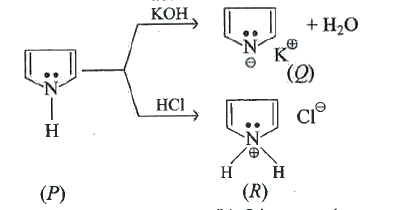Which is not true about the oxidation state of the following elements ?
Sulphur +6 to -2
Carbon +4 to -4
Chlorine +7 to -1
Nitrogen +3 to -1
The correct Answer is:D
To determine which statement about the oxidation states of the given elements (Sulfur, Carbon, Chlorine, and Nitrogen) is not true, we will analyze the oxidation states based on their electronic configurations.
1. Determine the Electronic Configuration of Each Element:
- Sulfur (S):
- Atomic number: 16
- Electronic configuration: 1s² 2s² 2p⁶ 3s² 3p⁴
- Carbon (C):
- Atomic number: 6
- Electronic configuration: 1s² 2s² 2p²
- Chlorine (Cl):
- Atomic number: 17
- Electronic configuration: 1s² 2s² 2p⁶ 3s² 3p⁵
- Nitrogen (N):
- Atomic number: 7
- Electronic configuration: 1s² 2s² 2p³
2. Identify Possible Oxidation States:
- Sulfur:
- Can gain 2 electrons to achieve Argon configuration (oxidation state: -2).
- Can lose 6 electrons to achieve Neon configuration (oxidation state: +6).
- Possible oxidation states: -2 to +6.
- Carbon:
- Can gain 4 electrons to achieve Neon configuration (oxidation state: -4).
- Can lose 4 electrons to achieve Helium configuration (oxidation state: +4).
- Possible oxidation states: -4 to +4.
- Chlorine:
- Can gain 1 electron to achieve Argon configuration (oxidation state: -1).
- Can lose 7 electrons to achieve Neon configuration (oxidation state: +7).
- Possible oxidation states: -1 to +7.
- Nitrogen:
- Can gain 3 electrons to achieve Neon configuration (oxidation state: -3).
- Can lose 5 electrons to achieve Helium configuration (oxidation state: +5).
- Possible oxidation states: -3 to +5.
3. Analyze the Given Options:
- The question asks for the statement that is not true regarding the oxidation states of these elements.
- The oxidation states for Nitrogen were calculated as -3 to +5, but if an option states that Nitrogen has oxidation states from +3 to -1, it is incorrect.
4. Identify the Incorrect Statement:
- The incorrect statement regarding Nitrogen's oxidation states is that it ranges from +3 to -1. The correct range is -3 to +5.
Conclusion:
The answer to the question is that the statement regarding Nitrogen having oxidation states from +3 to -1 is not true.
---
- Sulfur (S):
- Atomic number: 16
- Electronic configuration: 1s² 2s² 2p⁶ 3s² 3p⁴
- Carbon (C):
- Atomic number: 6
- Electronic configuration: 1s² 2s² 2p²
- Chlorine (Cl):
- Atomic number: 17
- Electronic configuration: 1s² 2s² 2p⁶ 3s² 3p⁵
- Nitrogen (N):
- Atomic number: 7
- Electronic configuration: 1s² 2s² 2p³
- Sulfur:
- Can gain 2 electrons to achieve Argon configuration (oxidation state: -2).
- Can lose 6 electrons to achieve Neon configuration (oxidation state: +6).
- Possible oxidation states: -2 to +6.
- Carbon:
- Can gain 4 electrons to achieve Neon configuration (oxidation state: -4).
- Can lose 4 electrons to achieve Helium configuration (oxidation state: +4).
- Possible oxidation states: -4 to +4.
- Chlorine:
- Can gain 1 electron to achieve Argon configuration (oxidation state: -1).
- Can lose 7 electrons to achieve Neon configuration (oxidation state: +7).
- Possible oxidation states: -1 to +7.
- Nitrogen:
- Can gain 3 electrons to achieve Neon configuration (oxidation state: -3).
- Can lose 5 electrons to achieve Helium configuration (oxidation state: +5).
- Possible oxidation states: -3 to +5.
- The question asks for the statement that is not true regarding the oxidation states of these elements.
- The oxidation states for Nitrogen were calculated as -3 to +5, but if an option states that Nitrogen has oxidation states from +3 to -1, it is incorrect.
- The incorrect statement regarding Nitrogen's oxidation states is that it ranges from +3 to -1. The correct range is -3 to +5.
The answer to the question is that the statement regarding Nitrogen having oxidation states from +3 to -1 is not true.
Topper's Solved these Questions
- BOOK - NCERT FINGERTPS ENGLISHCHAPTER - REDOX REACTIONSEXERCISE - MCQs (REDOX REACTIONS AND ELECTRODE PROCESSES)22videos
REDOX REACTIONS
- BOOK - NCERT FINGERTPS ENGLISHCHAPTER - REDOX REACTIONSEXERCISE - HIGHER ORDER THINKING SKILLS9videos
REDOX REACTIONS
- BOOK - NCERT FINGERTPS ENGLISHCHAPTER - REDOX REACTIONSEXERCISE - Assertion And Reason15videos
REDOX REACTIONS
- BOOK - NCERT FINGERTPS ENGLISHCHAPTER - PRACTICE PAPER 3EXERCISE - Practice Paper 346videos
PRACTICE PAPER 3
- BOOK - NCERT FINGERTPS ENGLISHCHAPTER - SOME BASIC CONCEPTS OF CHEMISTRY EXERCISE - NCERT Exemplar11videos
SOME BASIC CONCEPTS OF CHEMISTRY
Similar Questions
Knowledge Check
- Question 1 - Select One or More
Which is true about following reactions ?
 AP is aromaticBQ is aromaticCR is antiaromaticDR is non-aromatic
AP is aromaticBQ is aromaticCR is antiaromaticDR is non-aromatic
A metal, M from chaloride in its +2 and +4 oxidation states . Which of the following statement about thes chalorides is correct ?
View SolutionWhich element can have oxidation state from 4 to 6?
View SolutionWhich of the element shows +4 oxidation state?
View SolutionIn general, the Transition elements exhibit their highest oxidation states in their compounds with elements like:
View SolutionPossible oxidation states of boron family elements are :
View SolutionPossible oxidation states of boron family elements are :
View SolutionWhat are common oxidation states of group 15 elements?
View Solution

